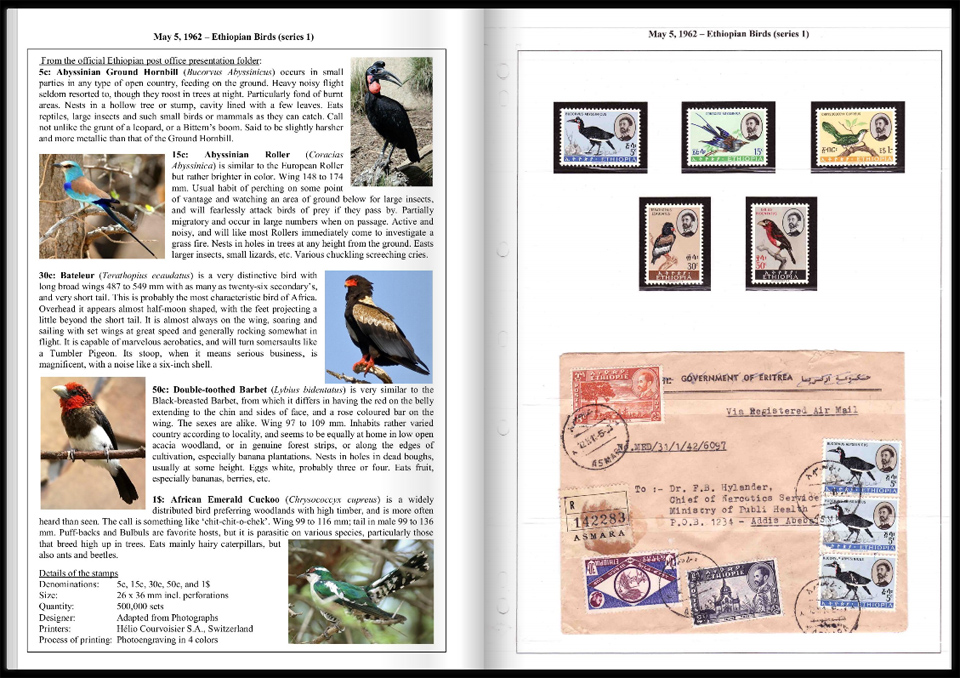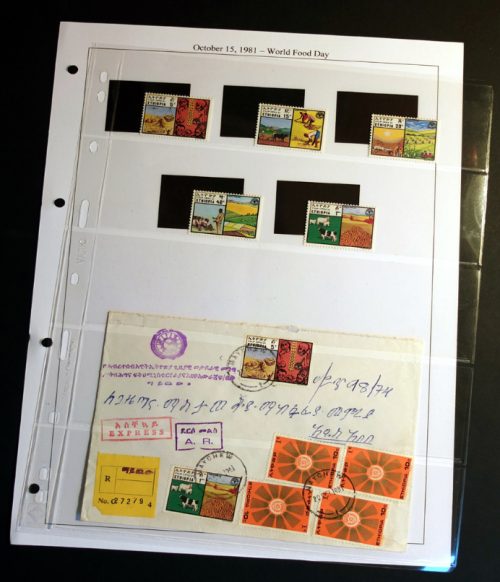How I created my stamp albums

<- Example of an album page
After having had my stamps in stock-books for several years I wanted to create my own albums. I experimented with different ways of presenting the stamps, and ended up with clear VARIO plastic pocket sheets from Lighthouse (Lechtrum). This because I wanted to present only mint stamps without hinges (MNH), and I got fed up of having to take them out of the albums to check the backside.
However, by using clear sheets I needed to have divider sheets, because an album with only clear sheets looks terrible. Having worked many years with computers I decided to use rather thick paper and print black squares as a background for the stamps to frame them. To frame the stamps exactly is not easy, and I had to make several test prints for each set get them right – sheet by sheet. At first I created several albums with 1-3 stamp sets per page, but after a while I got bored of looking at only the stamps. Collector-friends were not very interested in looking through my albums because they knew all the stamps so well.
After a few years I bought a couple of covers with stamps and nice postmarks on Internet, and as predicted by other club members I found them interesting. At one time I was lucky to buy quite many covers from a friend, and I decided to try to include some of them in my albums.
Leuchtturm did not have plastic pocket sheets where I could combine stamps and covers, and since I had already “invested” a lot in plastic pocket sheets I did not want to switch to another brand. I contacted Leuchtturm and asked if they could make some for me. Yes they could, but I had to order at least a thousand sheets (or was it more?), and quite expensive too, so that was out of the question.
Later I got the idea that I could try to cut the bottom of a pocket or two to be able to insert a cover behind several pockets. It worked, but of course it was not perfect. It does not look very professional, but it is good enough for me for presenting a traveled cover with each stamp set. Now the album became more interesting to look at.
The back sides of the divider sheets were at first blank. Something was missing, so I tried to print a description of each set there, using texts from books and Internet, and it looked better. Sometimes it was impossible to find a good description on Internet, and since I already had quite many of the Ethiopian post office presentation pamphlets/folders that came with the first day covers I started to use these texts instead. The albums look good now, but it was only after I started to illustrate the sets that the pages became interesting. I printed pictures from our family photo albums and from Internet, and the result was really nice – it looked so good that I decided to do this for all Ethiopian stamps.

I showed my albums to some friends, and they said that I should publish them as books to earn some money for all the long hours I have spent creating them. It would of course be nice to have some extra income, but I doubt that many people would buy these books. So I decided to just make them available on the Internet for everyone to enjoy.
I have experimented quite a lot with presentation quality, but decided that plain scans from my albums was good enough – even if the pockets are visible across the covers. To scan the covers separately and manipulate the stamp pages and the covers in Photoshop would take very long time. – Good enough is good enough.
My albums are not complete, but it is possible to buy the covers that are missing – even if some can be very expensive and difficult to find – which means that it may take years to fill the remaining ‘black holes’ in my albums. One problem is that I cannot use long or large covers as these are too big for my albums.
I created pdf-files that can be displayed in 2-page view, making them look like real albums. After checking around I found that Issuu.com had the solution I needed for presentation on Internet, and converted several test albums. The Issuu-type flip albums were OK to start with, but later I have changed to FLIPHTML5-type albums. I had hoped to find an easy solution for displaying the back sides of the covers by clicking on the images to “turn them”, since many have nice transit postmarks and labels, but that requires advanced programming. As an alternative solution I have scanned both sides of all the covers and added links in the index for each album, and also included a slider with the scans.
In addition to my albums with all the Ethiopian stamp sets I have included my specialty albums with revenue stamps, the 1942-43 stamp sets with all overprints and varieties, and the Italian Occupation period with all Italian colony stamp sets postmarked within Ethiopia to show that they were actually used in the country. I have also included some of my B&W and color postcards.
Current status
As you will see, not all albums are fully complete. I still have to finish my specialty albums for the 1942/43 issues, an album with stamps used during the Italian Occupation, and an album for my revenue stamps, but I have included scans so you can see what I am working with. There may be a ‘black hole’ here and there where stamps are missing, and I don’t have covers for all the sets yet, especially for the early sets, but I will update my albums as soon as I find more covers and stamps. I hope that someday I will be able to present all the beautiful Ethiopian stamps complete with travelled covers or postcards to illustrate that the sets were actually used. So if you have stamps, covers or postcards I need for my collection that you are willing to sell, please let me know.
I have tried to use the text from the presentation pamphlets/folders that came with the first day covers, because the Ethiopian Postal Service has done a very good job with presenting Ethiopia and their people, culture, flora, fauna, handcraft, etc. through stamps. By using this text I also preserve their description of the sets. Unfortunately I have had to shorten some of the longer texts because of the limited space in my albums, but I have added links to the full text on many of the album webpages. For the sets where I did not have pamphlets/folders I have used text from Internet and books, but I will replace some of these texts whenever I can find missing folders.
I also want to mention that I have copied several photos and illustrations from Internet to use in my albums. After finishing many albums, which has been a lot of work, I heard that many pictures on Internet have copyright. When I search for pictures now I always include the word ‘free’ in my search text, but if you by chance see one of your creations with copyright in one of my albums, please let me know, and I will replace the picture or, if you prefer, include your name under the picture.
